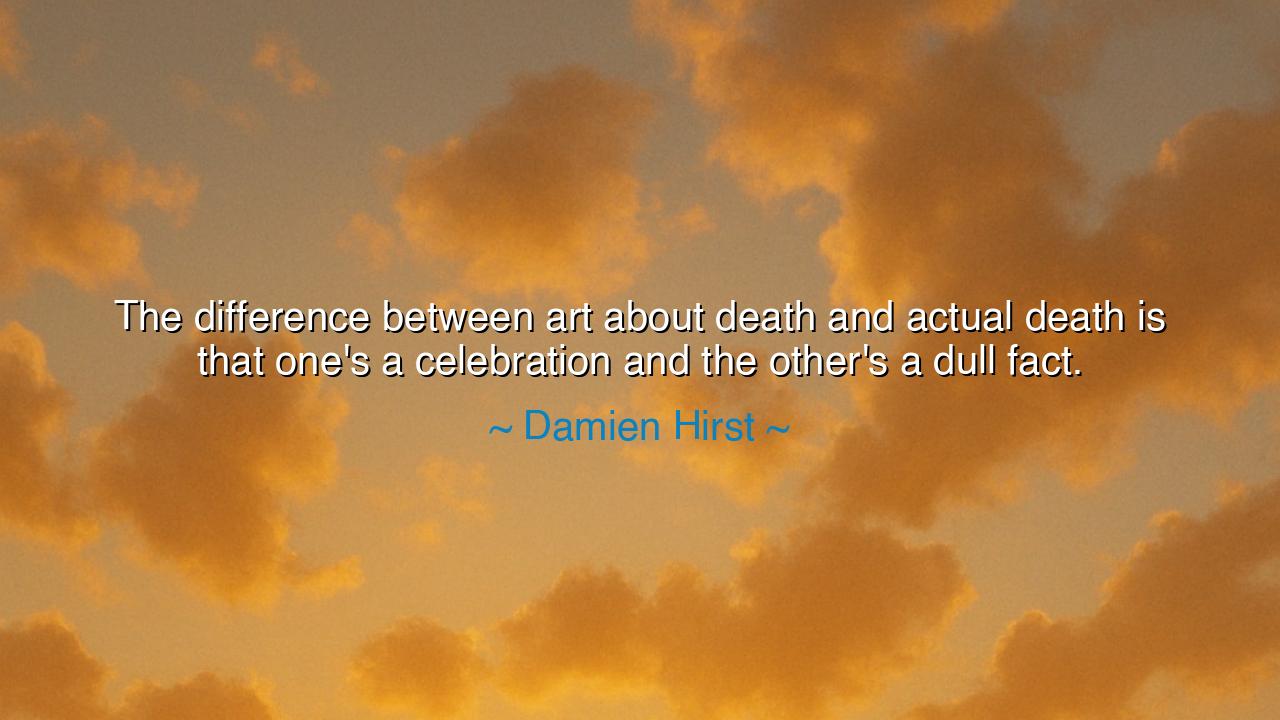
The difference between art about death and actual death is that
The difference between art about death and actual death is that one's a celebration and the other's a dull fact.






“The difference between art about death and actual death is that one’s a celebration and the other’s a dull fact.” Thus spoke Damien Hirst, the British artist whose work walks the razor’s edge between the sacred and the shocking. In these words, he reveals a paradox that lies at the very heart of human creation — that art transforms even the darkest realities into symbols of beauty, meaning, and transcendence. Death, which in its reality is final and silent, becomes through art an act of defiance, a cry of understanding, even a celebration. Hirst reminds us that while death ends life, art gives it form — and in doing so, redeems it from the realm of the dull, the inevitable, the unspoken.
The origin of this saying lies in Hirst’s own exploration of mortality. Few artists have confronted the subject as he has — with his famous works like The Physical Impossibility of Death in the Mind of Someone Living, where a great shark floats in a glass tank, suspended between life and eternity. In his art, Hirst takes what is most feared — decay, extinction, the end of being — and makes it visible, preserved, almost holy. His aim was never merely to shock, but to make people see: death is not an end, but a truth that demands to be faced. By calling death “a dull fact,” he strips it of mystery and terror, reminding us that the fact of dying is inevitable — what matters is how we respond to it, how we choose to shape its shadow through imagination and understanding.
“Art about death,” he says, “is a celebration.” For art transforms death from silence into song, from an ending into an image that endures. In art, the terror of mortality becomes something radiant — a flame that dances before it fades. The painter’s brush, the poet’s verse, the sculptor’s hand — these are the tools by which mankind has learned not to escape death, but to speak to it, to give it meaning. The ancients painted tombs, carved epitaphs, built monuments, not out of morbidity, but to declare: “We have seen death, and yet we live.” Art is the conversation between the living and the dead, the bridge across the chasm of time. It turns the dullness of the inevitable into the splendor of remembrance.
Consider the story of Michelangelo, who spent years painting The Last Judgment upon the altar wall of the Sistine Chapel. That vast vision of heaven and hell, of souls rising and falling, was his own dialogue with mortality. He knew his days were numbered, that his own flesh would soon decay — and so he made of death a vision, a celebration of divine justice and rebirth. The work does not mourn death; it exalts it as part of creation’s great design. In this way, Michelangelo lived Hirst’s truth centuries before he spoke it: that art conquers the dullness of death by transforming it into revelation.
To call actual death “a dull fact” is not to mock it, but to demystify it. Death itself has no poetry, no drama — it simply is. It comes without song or ceremony, indifferent to the rich and poor alike. What gives it resonance is our perception — the way the living choose to frame it. When an artist paints a skull or writes a requiem, he takes the dull fact and breathes spirit into it. He turns the cold inevitability of death into something that glows with meaning. Thus, in every culture and age, art has been humanity’s rebellion against the void — our refusal to let silence have the final word.
But Hirst’s quote carries another layer of wisdom: that celebration is not denial, but transformation. To celebrate death through art is to acknowledge its power while refusing to be enslaved by it. In celebrating, we are not exalting the end, but affirming the value of life. We say to death, “You will take the body, but not the beauty, not the truth, not the memory.” Through creation, we participate in eternity. Every song, every story, every painting is a small victory over time — proof that while the flesh fades, the spirit endures.
The lesson, then, is profound and timeless: face death, and make it beautiful. Do not turn from it in fear, nor cling to it in despair. Instead, let the certainty of death sharpen the purpose of your living. Create, love, forgive, build — for these are the ways the human spirit defies the dullness of the grave. The artist’s task is not limited to the canvas; it belongs to every soul that dares to find meaning in mortality. For to live with awareness of death is to live with intensity, and to turn life itself into a form of art.
So remember the wisdom of Damien Hirst: the difference between art about death and actual death is the difference between silence and song, between ending and eternity. Death, by itself, is a fact — cold and unfeeling. But through the act of creation, through courage and imagination, we turn that fact into a celebration — a declaration that even in the face of nothingness, humanity will still make something beautiful. For though death may silence the voice, it cannot silence the echo of those who dared to sing.






AAdministratorAdministrator
Welcome, honored guests. Please leave a comment, we will respond soon